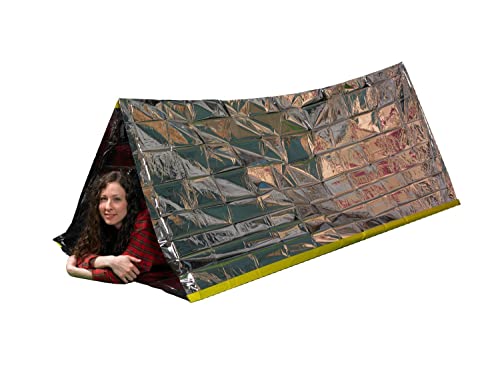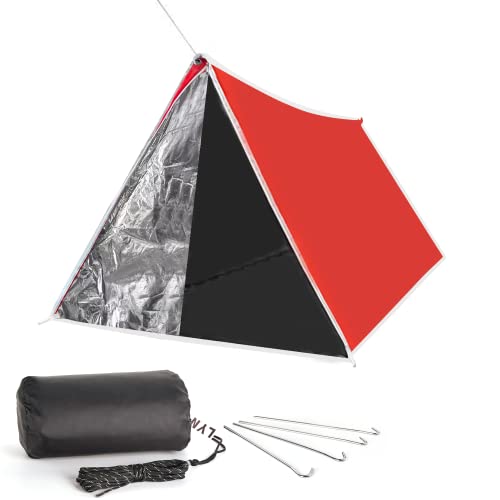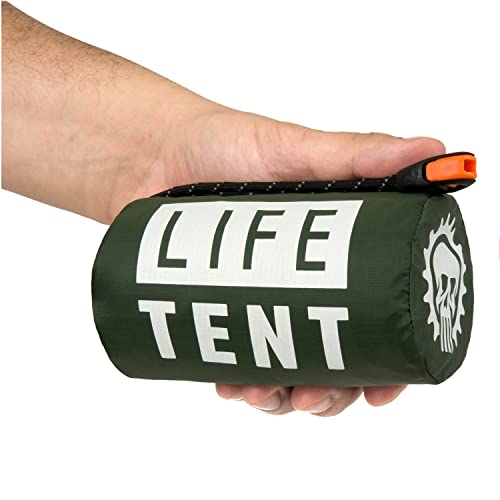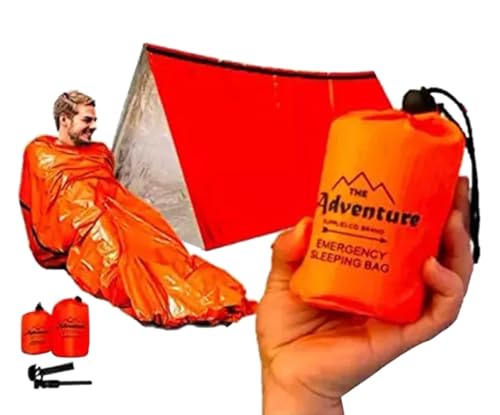You need the right survival gear kits to guarantee safety and preparedness on any adventure. Start with a first aid kit stocked with essentials like adhesive bandages, antiseptic wipes, and CPR equipment. Always carry reliable fire-starting tools such as ferro rods and waterproof matches. Pack an emergency blanket to retain body heat and a durable shelter option, like a tarp, for quick protection. Hydration solutions, including portable water filters and collapsible containers, are a must. Equip yourself with quality multi-tool and robust navigation equipment, such as a lensatic compass and waterproof maps. To discover more essential tips, keep exploring.
Key Takeaways
• Ensure first aid kit includes supplies for minor and serious injuries, plus CPR equipment.
• Bring multiple reliable fire-starting tools to ensure warmth and cooking capability.
• Carry a durable, collapsible water container for convenient hydration on the go.
• Include a versatile multi-tool for various cutting and fixing needs.
• Utilize a lensatic compass and durable topographic maps for reliable navigation.
Essential Features of Survival Kits

When assembling a survival kit, make sure it includes a thorough first aid kit to handle medical emergencies and injuries until professional help arrives. A well-prepared first aid kit is essential, containing basics like adhesive bandages, antiseptic wipes, gauze pads, and pain relievers. This guarantees you're equipped to manage minor wounds and more severe injuries in the wild.
Your survival kit wouldn't be complete without reliable fire starting tools. Pack multiple fire-starting methods such as ferro rods, waterproof matches, and fire tinders. These tools are crucial for staying warm, preparing food, and signaling for help.
An emergency blanket is another important component of your bug out bag. These lightweight, reflective blankets are designed to retain body heat, providing necessary warmth and protection against cold weather conditions. They also serve multiple purposes, doubling up as ground covers or makeshift shelters.
Additionally, durable shelter options should be considered. While tarps are great for creating temporary shelters, emergency blankets add that extra layer of security against the elements. Remember, these features are your lifeline in unpredictable environments, making sure you're ready to face any challenge nature throws your way.
Hydration Solutions for Adventures
Assuring adequate hydration on your adventure is paramount, requiring around 2-3 liters of water daily to maintain peak physical performance and prevent dehydration. Effective hydration strategies include carrying a collapsible water container, which is lightweight and convenient for transport, guaranteeing you always have a supply on the go without adding significant bulk to your gear.
For longer excursions, incorporating water purification methods into your emergency kit is essential. Portable water filters and purification tablets can transform practically any natural water source into safe drinking water, protecting you from harmful pathogens. Hydration bladders fitted with built-in filtration systems offer another layer of safety and convenience, allowing easy access to clean water while you hike or camp.
Don't overlook the importance of planning ahead, especially in hot climates or at high altitudes, where the risk of dehydration increases. Monitor your water intake closely, and always guarantee you have a reliable means of replenishing your supply.
Equip your emergency kit with both a collapsible water container and purification tools, providing peace of mind and preparedness for any hydration challenges you may encounter on your adventure. Proper planning and gear will keep you resilient and ready for anything.
Fire-Making Tools to Carry

To survive the wild, you'll need fire-making tools that are reliable, versatile, and easy to carry. Fire is one of the most critical survival essentials, offering warmth, a means to cook food, and the ability to signal for help during an emergency. Equip yourself with a combination of fire-starting methods to increase your chances of success.
Ferrocium rods are extremely durable and can ignite a spark in almost any weather condition. Similarly, flint and steel kits offer reliable sparks but require some skill to master.
Waterproof matches are a great addition to your survival gear, guaranteeing that even in wet conditions, you can start a fire. Mini inferno fire discs and magnesium fire starters are lightweight and compact, perfect for fitting into your kit without adding unnecessary bulk.
Make sure you carry multiple options, as relying on a single method could lead to failure in critical situations. Practice using these tools regularly to develop your proficiency. This guarantees that when you're faced with the task of starting a fire in the wild, you're confident and efficient.
These meticulously chosen fire-making tools are indispensable for any complete survival kit.
First Aid Supplies You Need
Your first aid kit's essential supplies include adhesive bandages, antiseptic wipes, gauze pads, adhesive tape, and scissors to handle common injuries efficiently. These items form the backbone of your first aid kit, allowing you to address cuts, scrapes, and minor wounds quickly.
To be fully prepared for any emergency, stock your kit with a variety of medications. Pain relievers, antihistamines, and anti-inflammatory drugs are essential items that help manage headaches, allergic reactions, and swelling. Having these medications at hand guarantees that you can cope with different health issues that might arise during your adventure.
Additionally, include a CPR face shield or mask in your first aid kit for safe resuscitation efforts. This item provides a critical barrier and guarantees you can perform life-saving maneuvers without hesitation. For more serious incidents, a burn dressing, triangular bandage, and splint materials are indispensable. These components help manage severe injuries such as burns, sprains, and fractures.
Lastly, regularly check and replenish your first aid kit to guarantee it's fully stocked with up-to-date items. This proactive approach ensures that each essential item is usable when you need it most, keeping you ready for any emergency.
Multi-Tools and Wilderness Gear

Beyond first aid supplies, multi-tools and wilderness gear play an important role in equipping adventurers for any challenges they may encounter in the wild.
A well-rounded survival kit must include a quality multi-tool, which is indispensable for its versatility. Whether you need to cut rope, saw through branches, or tighten screws, a multi-tool can handle it all. Look for models made from durable, weather-resistant materials to guarantee they withstand harsh conditions typical of outdoor adventures.
Your survival kit should also feature a reliable fire starter. When temperatures drop or you need to prepare food, the ability to start a fire is crucial. Compact and efficient fire starters can be lifesavers in these situations.
Alongside your multi-tool and fire starter, a high-quality folding knife is another key item. Its sharp, locking blade can perform a variety of tasks, from preparing meals to fashioning tools.
These pieces of gear not only provide practical solutions but also contribute greatly to your overall safety and preparedness. By thoughtfully selecting the right multi-tools and wilderness gear, you'll be ready to tackle any situation that comes your way during your outdoor adventures.
Navigation Equipment for Safety
When venturing into the wilderness, having a robust navigation system, including a lensatic compass and waterproof topographic maps, is vital for guaranteeing safety and successful route-finding. A lensatic compass stands out for its durability and reliability, helping you maintain accurate bearings even in rugged terrains. Pairing this with waterproof maps guarantees that your navigation equipment remains functional despite adverse weather conditions or accidental submersion.
Your survival kit should also include backup navigation tools, such as water-resistant button compasses. These lightweight, air-filled options can be essential when your primary navigation equipment is compromised. Confirm that your topographic maps are made of durable plastic and feature clearly marked resources to aid in route planning. They should withstand harsh conditions to avoid disintegration when wet or torn.
Maintaining a total gear weight within 25% of your body weight, including your navigation tools, is vital for ease of movement in the wilderness. Staying equipped with reliable navigation systems, like a lensatic compass and extensive waterproof maps, greatly enhances your safety and situational awareness.
This thorough preparation allows you to navigate confidently and tackle the challenges of outdoor adventures.
Shelter Options for Various Environments

Equipping yourself with the right shelter options tailored to different environments is essential for guaranteeing comfort and safety during outdoor adventures. When preparing your survival kit, you'll want to take into account the specific needs of each environment.
In cold regions, canvas tents or teepees provide excellent insulation and stand up to harsh winds, keeping you warm. Don't forget to include emergency sleeping bags to add an extra layer of protection against hypothermia.
For wet conditions, lightweight waterproof tarps are indispensable. These can quickly be assembled as emergency shelters, giving you protection from rain and wind without adding significant weight to your gear.
If you're venturing into tropical or hot climates, a mesh hammock with a rainfly offers a comfortable and ventilated solution, keeping you off the ground and away from pesky insects.
Thinking about mobility? Collapsible or inflatable shelters are great emergency options for transient situations, as they can be swiftly set up and packed down.
Learning to build a shelter using natural materials is also a valuable skill, but having these versatile items in your kit guarantees you're prepared for a range of scenarios, making your adventures safer and more enjoyable.
Food and Cooking Essentials
With your shelter secured, the next priority in your survival gear kit should be confirming you have the right food and cooking essentials to sustain you throughout your adventure.
High-density non-perishable foods are important. Aim for a daily caloric intake around 1250 calories, incorporating whole milk powder, brown rice, and honey to achieve a balanced nutritional profile. These items provide necessary fats, carbohydrates, and proteins needed for sustained energy.
Important cooking gear should include a 1-liter titanium pot and flexible utensils. These are lightweight and efficient, making meal preparation straightforward. Fire starting tools, such as ferrocium rods and multiple lighters, are critical. These tools help you cook and stay warm, while lens-based fire starters offer reliability in various conditions.
Meal rations in your survival kit must consider macronutrient ratios, focusing on fats, carbohydrates, and proteins. This guarantees you maintain energy and overall health during extended outdoor activities.
Finally, include items for food storage and preparation, such as resealable bags or containers. These keep your food fresh, accessible, and minimize waste, important for any adventure.
Prioritizing these essentials assures you're prepared for whatever comes your way.
Frequently Asked Questions
What Does Every Survival Kit Need?
Did you know 95% of wilderness emergencies are due to lack of preparation? Every survival kit needs a reliable fire starter, navigation tools, a first aid kit, water purification, and durable multi-functional tools to guarantee your safety.
What Are the Top 7 Survival Items?
The top 7 survival items you need include a first aid kit, fire starters, water purification system, shelter, multitool, compass, and food supplies. These essentials guarantee you're prepared and safe during any adventure, no matter the conditions.
What Is the Most Essential Survival Tool?
Imagine being lost in the woods; your multi-tool becomes your Swiss Army knife for survival. It's versatile, combining functions like cutting and prying. This adaptability makes it the most essential tool for any unpredictable situation.
Should Everyone Have a Survival Kit?
Yes, you should have a survival kit. It guarantees you're prepared for emergencies, enhances your safety, and provides essential supplies like first aid, navigation tools, and fire starters, making you ready for any unforeseen circumstances.




